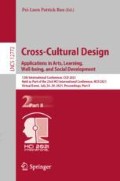Abstract
Art training could improve our ability to discover and express beauty, yet we don’t know much about the effect of art training. With rectangle as the research object, this study evaluates the influence of art training on proportion control of rectangles via experiments and using of Bloom classification theory, so as to understand the effect of art training and the differences existing in proportion preference of contemporary audiences. According to the research: 1. Art training could effectively improve the subjects’ ability of cognitive judgement towards proportion, as well as creativity. 2. Education level has positive influence on overall proportion control. 3. The most popular rectangle proportion is 1: 1.618, followed by 1:1 and 1:2.
Access this chapter
Tax calculation will be finalised at checkout
Purchases are for personal use only
References
Palmer, S.E., Schloss, K.B., Sammartino, J.: Visual aesthetics and human preference. Ann. Rev. Psychol. 64, 77–107 (2013)
Leder, H., Belke, B., Oeberst, A., Augustin, D.: A model of aesthetic appreciation and aesthetic judgments. Brit. J. Psychol. 95(4), 489–508 (2004)
Bloom, B.S., Englehart, M.D., Furst, E.J., Hill, W.H., Krathwohl, D.R. (eds.): Taxonomy of Educational Objectives. HANDBOOK I: Cognitive Domain, pp. 4–5. David McKay, New York (1956)
Anderson, L.W., Krathwohl, D.R. (eds.): A Taxonomy for Learning, Teaching and Assessing: A Revision of Bloom's Taxonomy of Educational Objectives. Complete edition. Longman, New York (2001)
Rutkowski, J., Moscinska, K., Jantos, P.: Application of Blooms taxonomy for increasing teaching efficiency–case study. In: International Conference on Engineering Education ICEE-2010 (2010)
Katsuhiro, K., Chen, Z.: Building Form Means. China Building Industry Press, Beijing (2003)
Ji, T., Yi, Q.: Return of the orde: comment on katsuhiro kobayashi' s work “building form means”. Comments Forum, 35–37 (2011)
Fecbner, G.T.: Vorschule der Aesthetik [Prolegomenon to Aesthetics]. Breitkopf & Haertel, Leipzig (1876)
McManus, I.C.: Tbe aestbetics of sitnple figures. Brit. J. Psychol. 71, 505–524 (1980)
McManus, I.C., Cook, R., Hunt, A.: Beyond tbe golden section and normative aesthetics: why do individuals differ so much in tbeir aestbetic preferences for rectangles? Psychol. Aesthetics Creativity Arts 4, 113–126 (2010)
Davis, F.C.: Aesthetic proportion. Am. J. Psychol, 45, 298–302 (1933)
Jung, R.: Art and visual abstraction. In: Gregory, R.L. (ed.) The Oxford Companion to the Mind, p. 46. Oxford Univ. Press, New York (1987)
Nodine, C.F., Locher, P.J., Krupinski, E.A.: The role of formal art training on perception and aesthetic judgment of art compositions. Leonardo 26(3), 219–227 (1993)
Walker, E.L.: Psychological Complexity and Preference: A Hedgehog Theory of Behavior. Brooks-Cole, New York (1980)
Pihko, E., et al.: Experiencing art: the influence of expertise and painting abstraction level. Front. Human Neurosci. 5, 94 (2011)
Bragg, B.W.E., Crozier, J.B.: The development with age of verbal and exploratory responses to sound sequences varying in uncertainty level. In: Berlyne, D.E. (ed.) Studies in the New Experimental Aesthetics, pp. 91–108. Hemisphere, Washington (1974)
Francès, R.: Comparative effects of six collative variables on interest and preference in adults of different educational levels. J. Pers. Social Psychol. 33, 62–79 (1976)
Silvia, P.J.: Artistic training and interest in visual art: applying the appraisal model of aesthetic emotions. Empir. Stud. Arts 24(2), 139–161 (2006)
Crozier, J.B.: Verbal and exploratory responses to sound sequences varying in uncertainty level. In: Berlyne, D.E. (ed.) Studies in the New Experimental Aesthetics, pp. 27–90. Hemisphere, Washington (1974)
Locher, P.J., Smith, J.K., Smith, L.F.: The influence of presentation format and viewer training in the visual arts on the perception of pictorial and aesthetic qualities of paintings. Perception 30, 449–465 (2001)
Millis, K.: Making meaning brings pleasure: the influence of titles on aesthetic experience. Emotion 1, 320–329 (2001)
Huntley, E.H.: The Divine Proportion. Dover, New York (1970)
Berlyne, D.E.: Aesthetics and Psychobiology. Appleton-Century-Crofts, New York (1971)
Ching, F.D.K.: Architecture: Form, Space, and Order. Van Nostrand Reinhold, New York (1979)
Enjafield, J., Pomeroy, E., Saunders, M.: The golden section and the accuracy with which proportions are drawn. Canad. J. Psychol. 34, 253–256 (1976)
Goldenberg, E.P., Cuoco, A.A.: What is dynamic geometry? In: Lehrer, R., Chazan, D. (eds.) Designing Learning Environments for Developing Understanding of Geometry and Space, pp. 351–367. Erlbaum, Mahwah (1998)
Livio, M.: The golden ratio: the story of phi, the world's most astonishing number. Crown, 178–183 (2008)
Zeising, A.: Der goldne Schnitt. Druck von E. Blochmann & Son in Dresden, Halle (1884)
Hekkert, P., Peper, C.L.E., Van Wieringen, P.C.: The effect of verbal instruction and artistic background on the aesthetic judgment of rectangles. Empir. Stud. Arts 12(2), 185–203 (1994)
Höge, H.: Fechner’s experimental aesthetics and the golden section hypothesis today. Empir. Stud. Arts 13(2), 131–148 (1995)
Höge, H.: The golden section hypothesis—a funeral, but not the last one. Visual Arts Res. 22, 79–89 (1996)
Russell, P.A.: The aesthetics of rectangle proportion: effects of judgment scale and context. Am. J. Psychol. 113(1), 27–42 (2000)
Schiffman, H.R., Bobka, D.: Preference in linear partitioning: the golden section reexamined. Percept. Psychophys. 24, 102–103 (1978)
Author information
Authors and Affiliations
Editor information
Editors and Affiliations
Rights and permissions
Copyright information
© 2021 Springer Nature Switzerland AG
About this paper
Cite this paper
Gao, Y., Huang, J., Wu, J., Lin, R. (2021). Study on the Effect of Art Training on Proportion Control. In: Rau, PL.P. (eds) Cross-Cultural Design. Applications in Arts, Learning, Well-being, and Social Development. HCII 2021. Lecture Notes in Computer Science(), vol 12772. Springer, Cham. https://doi.org/10.1007/978-3-030-77077-8_12
Download citation
DOI: https://doi.org/10.1007/978-3-030-77077-8_12
Published:
Publisher Name: Springer, Cham
Print ISBN: 978-3-030-77076-1
Online ISBN: 978-3-030-77077-8
eBook Packages: Computer ScienceComputer Science (R0)

